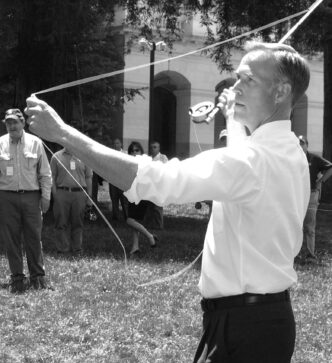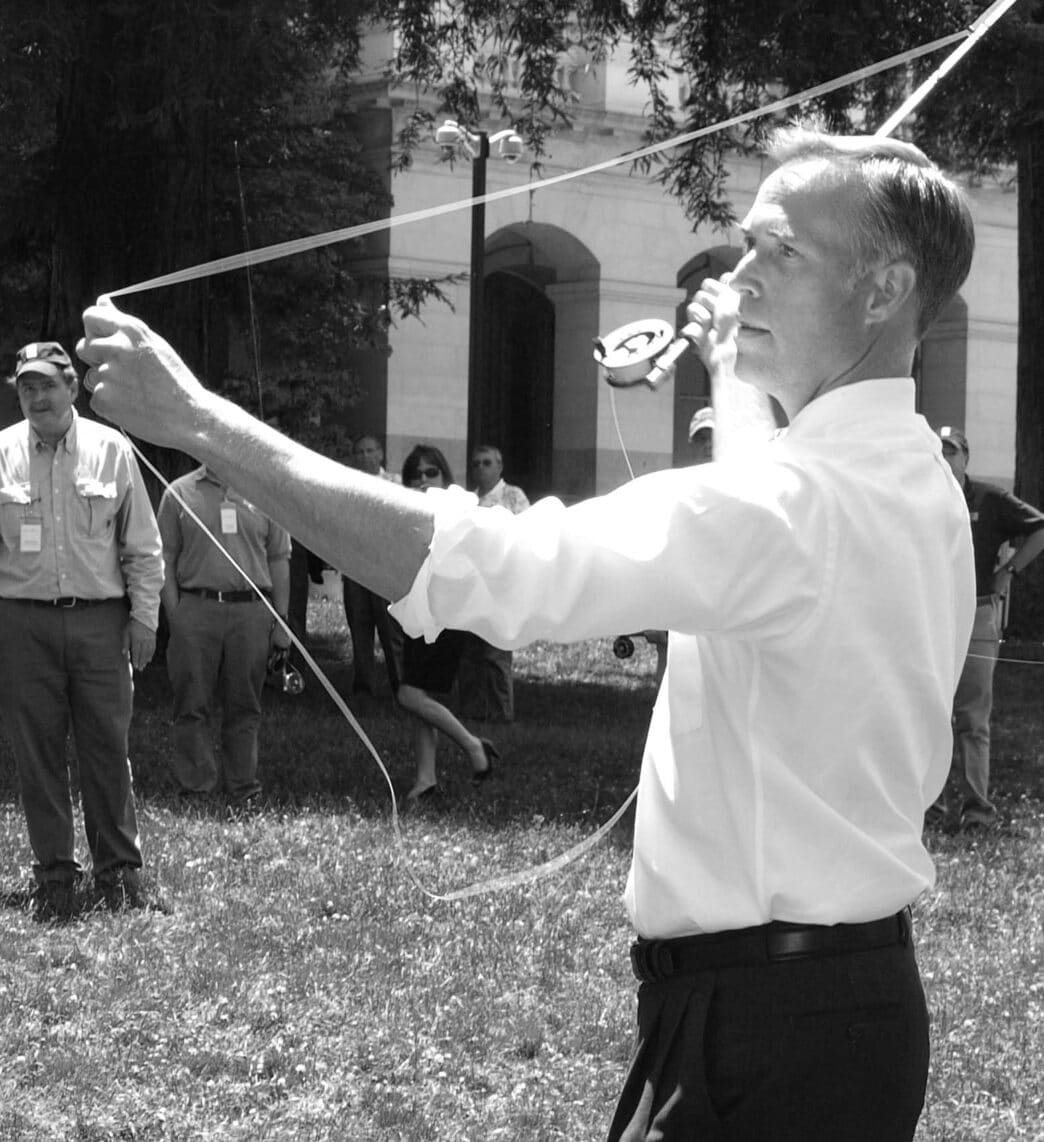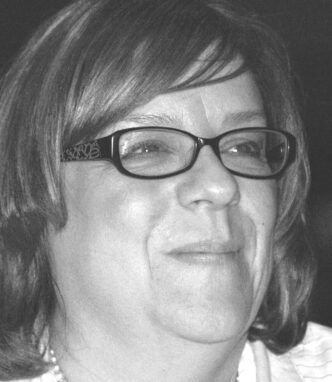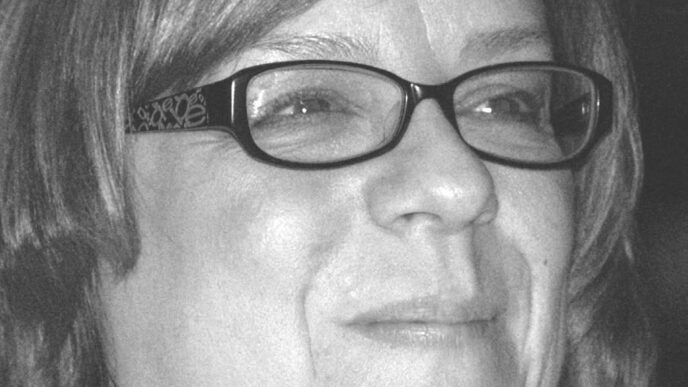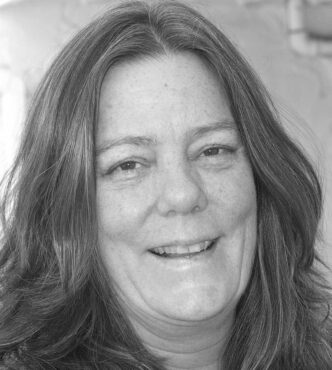In June, California’s two biggest trout groups brought their fly rods to the State Capitol for a PR event designed to catch the ear of lawmakers. The fly rods were not actually in the capitol, but used for a casting contest for legislators on the lush, grassy capitol grounds.
The event — dubbed the “Casting Call” — kicked off the new lobbying effort by California Trout and Trout Unlimited, groups that have a total combined membership of 16,000 in California.
A few legislators came out of the building to stand on the grass and cast bits of yarn in an effort to hit pictures of Goose Lake redband, Lahontan cutthroat, and Eagle Lake rainbow trout that were pasted onto Styrofoam boards.
Two legislators long involved with fish and water issues, State Assembly Member Jared Huffman, D-San Rafael, and State Senator Dave Cogdill, R-Fresno, squared off for the contest. Another good-natured lawmaker, State Senator Lou Correa, D-Orange County, came out to get some one-on-one casting instruction from the volunteers at the event.
As with any such made-for-media event, there was no actual winner in the contest, which ended with plenty of political backslapping and congratulations and campaignlike promises.
“I’ve got to get out and fish more,” said Cogdill, before disappearing back into the capitol building for another round of hearings. “I’ve got to get out and fish more,” echoed Huffman, a fly fisher and former senior staff attorney for the Natural Resources Defense Council. He, too, disappeared into the capitol, where committees are wrangling over the out-of-balance California state budget.
Such PR shows by advocacy groups are not unusual at the capitol, particularly during the budget debate, when funding for programs might get whacked. However, in the world of trout conservation, the affair was unusual, because it kicked off an effort by the sometimes bickering trout groups to work together on legislative and state agency issues.
In the past, differences in policy between CalTrout and TU had been the subject of streamside campfire discussions among trout conservationists in the state. In the 1960s, a group of TU volunteers had a disagreement with the national office about how much of their dues and fundraising money the organization was returning to pay for work on California conservation issues. The tiff caused TU volunteers, led by Joe Paul and others, to leave the organization and start their own conservation group, California Trout. CalTrout has grown into an organization that now has 11 staff members working out of six offices across the state.
Many of the leaders who were involved in that split have retired or are no longer active with the two organizations, so the breakup is now merely an historical footnote for conservation insiders. For current staffers at CalTrout and TU, working separately on state legislative issues simply made no sense.
“Our missions are similar, and our membership is similar,” said Chuck Bonham, a Berkeley-based attorney who heads TU’s California efforts and who also is leading that organization’s new lobbying venture. “And the fish don’t care. We can simply get more done working with CalTrout.”
That sentiment is echoed by Curtis Knight, the CalTrout staffer who is leading that group’s new lobbying effort out of his office in Mount Shasta. “At CalTrout, we see this as an evolution in our partnership with TU. There is a lack of a clear, cohesive voice for fish in Sacramento. We have an opportunity in combining our resources and speaking as one.”
The new CalTrout-TU partnership does fill an advocacy gap, particularly on inland sport-fishing issues. Over the years, fishery issues at the state level have been dominated by advocacy groups lobbying for attention to problems relating to the Sacramento–San Joaquin Delta and commercial fishing. For example, Zeke Grader, who heads the Pacific Coast Federation of Fishermen’s Associations (PCFFA), plays an active and leading role in advocating for commercial fishing interests at the capitol, including sponsoring an annual fisheries legislative forum. That forum, however, focuses primarily on commercial fishing issues and provides limited attention to inland sport fisheries. The annual PCFFA sponsored postforum fish barbecue that is held in the basement of a downtown cathedral — complete with free beer — also provides an informal opportunity for commercial fishing advocates to lobby legislators and their staff.
The TU and CalTrout “Casting Call” isn’t the first effort to focus on lobbying for trout at the state level. Previously, the Sacramento-based Planning and Conservation League made an attempt to organize anglers, particularly members of fly-fishing clubs who are part of the Northern California Council of the Federation of Fly Fishers, which had been relatively active at the capitol. That effort, however, was short-lived. And CalTrout had recently hired a former legislative staff member to lobby out of an office a few blocks from the capitol, but that person was let go to save money during the economic downturn.
As part of the new, united advocacy effort, CalTrout and TU have hired the environmentally oriented commercial lobbying firm Conservation Strategy Group (CSG), whose other clients include The Nature Conservancy, Audubon California, the Environmental Defense Fund, the Monterey Bay Aquarium, many land trusts, and the California State Parks Foundation.
According to Knight and Bonham, the groups and CSG will focus initially on two bills, one dealing with a relatively uncontroversial subject and the other tackling a large and politically complex agency reform issue.
The relatively uncontroversial measure is Assembly Bill 2063, which would designate the chinook salmon as the official state anadromous fish. The groups hope that the designation will result in a heightened effort to protect and restore the species. Some runs of chinooks are threatened with extinction. The bill has been introduced by Huffman and is under review by legislative committees.
According to TU’s Bonham, California does not have a state anadromous fish. “The state marine fish is the garibaldi,” he said. “Apparently there is a garibaldi lobby.” The state’s freshwater fish is the golden trout.
As drafted, AB-2063 directs the California Department of Fish and Game to “utilize the best available science, a life cycle analysis, and scientifically driven hatchery operations in determining where to focus and prioritize conservation planning efforts for recovery of the Chinook salmon and other salmonid species.”
The more complex and politically charged measure is Assembly Bill 2376, also introduced by Huffman, which would set out a process for reforming the DFG and its policy-making parent, the Fish and Game Commission. As drafted, AB-2376 would require that the California Resources Agency empanel a committee to recommend a “strategic vision” for the department and commission before July 1, 2012. Under the legislation, this committee would develop strategies to “improve
and enhance the department’s capacity to fulfill its public trust responsibilities to protect and manage the state’s fish and wildlife.”
The strategies should include making “reforms necessary to take on the challenges of the 21st Century,” including climate change and adaptation, meeting the state’s renewable energy needs while protecting wildlife, restoring native fish species, improving the state’s technical capacity to protect and monitor fish populations, managing its agency budgets, and identifying stable funding options. In addition, the strategies must include “recommendations for institutional or governance changes, including clarification of the roles of the commission and the department.”
Members of the review panel would include the secretary of the Natural Resource Agency, the director of the DFG, the president of the Fish and Game Commission, the chair of the state’s energy commission, and a representative of the University of California. Representatives of the U.S. Fish and Wildlife Service and National Marine Fisheries Service would be invited to participate. In addition, a citizen-based advisory committee would be created to review the issues. According to CalTrout’s Knight, it is hoped that the review panel would be similar to Governor Arnold Schwarzenegger’s blue-ribbon group that just completed a comprehensive review of state policies related to the California Delta.
That committee was made up of agency heads and Delta experts who held lengthy meetings, conducted intensive studies, and produced a set of recommendations that was turned into a legislative package. The report split the fishery and environmental communities, because it recommended a bond issue to build more water-storage reservoirs and a peripheral canal to route water around the Delta. Many conservation groups are actively opposing an $11.14 billion water bond to fund the storage and some canal work that voters will consider on the November 2 ballot.
“Looking back at the S.O.S. report, one of the primary recommendations was to find stable funding sources” for the Department of Fish and Game, said Knight, referring to the CalTrout-produced report titled S.O.S.: California’s Native Fish Crisis (httnias-Native-Fish-Crisis.pdf ). “When you say Fish and Game reform, it makes people bristle. We’ll see what we can do to help the department.” Knight said he hoped that AB-2376 would be approved by the legislature and signed into law before the next governor takes office. Pending the outcome of the November election, the next governor will be either Republican Meg Whitman, the former eBay CEO, or Democrat Jerry Brown, a former governor of California.
With so much interest and focus on protecting and restoring the Delta, the next governor will probably be reluctant to tackle another major environmental issue, such as reforming the fish-and-game agencies. The focus of the gubernatorial campaign has been on how to create jobs, rather than environmental problems. In her campaign, Whitman has endorsed the water bond and canal, while Brown, as of mid-June, has taken no position, although he did approve a ballot measure to build the Peripheral Canal in 1982, one that was rejected by an overwhelming majority of California voters.
Even if the new CalTrout-TU activists don’t get active on Delta legislation, there are plenty of trout-oriented legislative measures to keep them busy.
Assembly Bill 1189 would require the California Department of Transportation to complete an assessment of road barriers that block streams and fish passage and sets up a process for removing or fixing them. CalTrout and TU support AB1189, which was introduced by State Assembly Member Nancy Skinner, DBerkeley, and is pending in the Assembly Transportation Committee.
Senate Bill 1218, introduced by Senator Dean Florez, D-Shafter, would require the DFG to conduct a study to assess the impact of hatcheries on naturally spawning fish. The bill is under review by Senate committees.
Senate Bill 539, introduced by Senator Patricia Wiggins, D-Santa Rosa, would create a California Ocean Protection Trust Fund that would be used to pay for salmon and steelhead protection and restoration projects. The bill has been approved by the State Senate and is under review in State Assembly committees.



